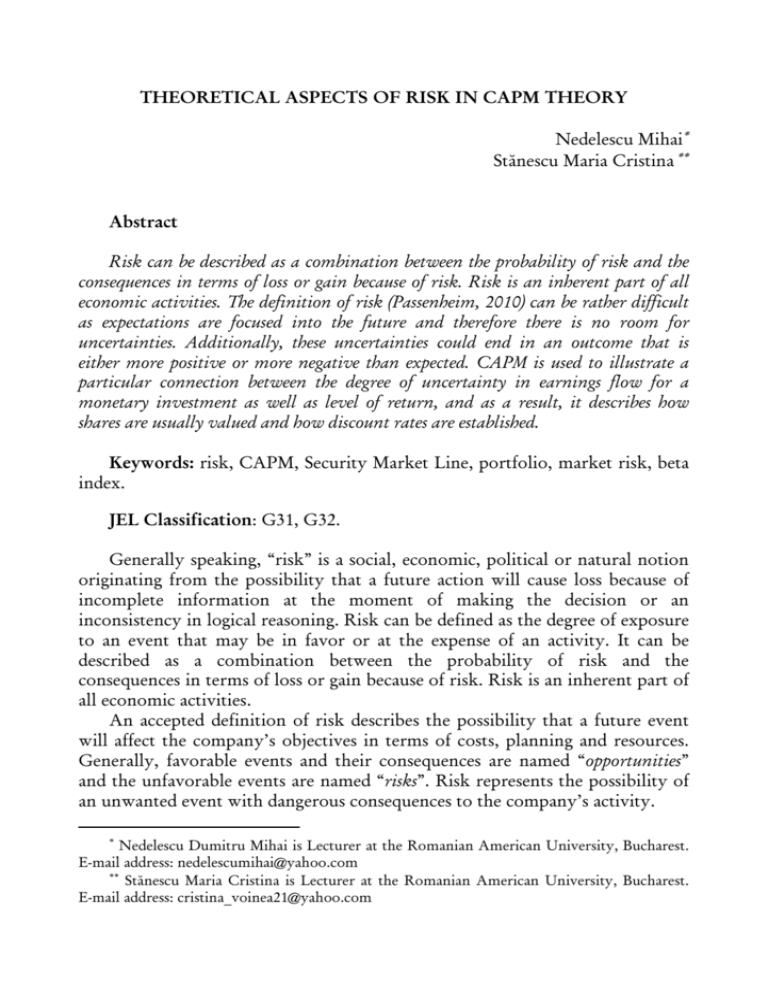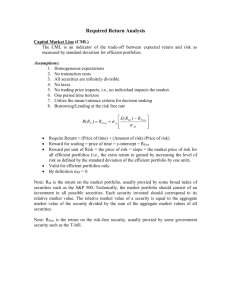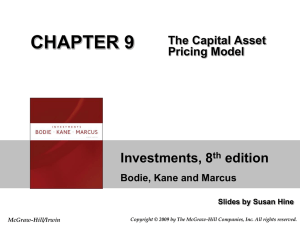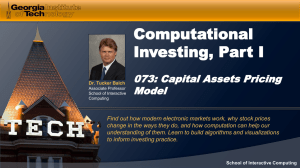
60
Theoretical aspects of risk in capm theory
THEORETICAL ASPECTS OF RISK IN CAPM THEORY
Nedelescu Mihai∗
Stănescu Maria Cristina ∗∗
Abstract
Risk can be described as a combination between the probability of risk and the
consequences in terms of loss or gain because of risk. Risk is an inherent part of all
economic activities. The definition of risk (Passenheim, 2010) can be rather difficult
as expectations are focused into the future and therefore there is no room for
uncertainties. Additionally, these uncertainties could end in an outcome that is
either more positive or more negative than expected. CAPM is used to illustrate a
particular connection between the degree of uncertainty in earnings flow for a
monetary investment as well as level of return, and as a result, it describes how
shares are usually valued and how discount rates are established.
Keywords: risk, CAPM, Security Market Line, portfolio, market risk, beta
index.
JEL Classification: G31, G32.
Generally speaking, “risk” is a social, economic, political or natural notion
originating from the possibility that a future action will cause loss because of
incomplete information at the moment of making the decision or an
inconsistency in logical reasoning. Risk can be defined as the degree of exposure
to an event that may be in favor or at the expense of an activity. It can be
described as a combination between the probability of risk and the
consequences in terms of loss or gain because of risk. Risk is an inherent part of
all economic activities.
An accepted definition of risk describes the possibility that a future event
will affect the company’s objectives in terms of costs, planning and resources.
Generally, favorable events and their consequences are named “opportunities”
and the unfavorable events are named “risks”. Risk represents the possibility of
an unwanted event with dangerous consequences to the company’s activity.
∗
Nedelescu Dumitru Mihai is Lecturer at the Romanian American University, Bucharest.
E-mail address: nedelescumihai@yahoo.com
∗∗
Stănescu Maria Cristina is Lecturer at the Romanian American University, Bucharest.
E-mail address: cristina_voinea21@yahoo.com
Romanian Economic and Business Review – Vol. 10, No. 2, 2015
61
Risk also describes the possibility of an anticipated result to be better or
worse than the expected one, this feature emphasizing over the fact that risk is
equivalent to the variability of possible results.
Most of the time, risk has a negative meaning, investors being interested
more in lack of appreciation to gains. Therefore, risk can also mean the
possibility of getting better results than expected. Therefore, risk means hazard,
the danger of loss, “the possibility of exposing oneself to loss” or a possible lost
“that modern policy tries to prevent or fix”.
The risk management procedure is based upon reiteration and feedback,
therefore its effectiveness must be constantly analyzed through several
strategies: risk avoidance, reduction, protection, risk managing and risk
transfer; feasible techniques of performing that consist of taking out insurance
coverage or sub-contracting.
The Capital Asset Pricing Model (CAPM) is used to illustrate a particular
connection between the degree of uncertainty in earnings flow for a monetary
investment as well as level of return, and as a result, it describes how shares are
usually valued and how discount rates are established. This model separates the
shares’ risk in two categories: systematic and unsystematic risks (Allan Hill,
2010).
Figure 1: The Inter-relationship of Risk Concepts (Allan Hill, 2010)
Systematic Risk Systematic Market Risk bears its name due to the
endemicity characteristic (through the system) and its lack of diversity and
predictability. Systematic risk refers to the extent to which share returns vary
when the returns on the market as a whole change; it is measured by beta. It
relates to general economic factors that affect all firms and financial securities
62
Theoretical aspects of risk in capm theory
and explains why share prices tend to move in sympathy. A share with a beta of
1 tends to rise by 10% for a 10% rise in the index; a share which has a beta of 2
tends to rise by 20% once the returns to the market rise by 10% percent. To put
it simply, shares of businesses with increased betas are far more volatile.
No company is completely unaffected by modifications in these variables
and therefore the costs of practically all shares tend to move together and are
usually positively correlated (Allan Hill, 2010).
Unsystematic Risk Unsystematic risk is that portion of complete risk,
which is unique to a company (industry); frequently referred to as residual or
specific risk, it relates to particular economic aspects, which influence
individual industries, firms, securities and projects, for instance the quality of
management or equipment failure. Due to the fact that this kind of risk is
specific for the company, it is actually possible to reduce the variability of
investors’ returns by choosing not to place all funds in a single firm. It could
also be removed completely, by means of effective diversification, as it can be
seen in Figure 2, where the quantity of unsystematic risk minimizes as the
amount of individual types of share in the portfolio increases:
Figure 2: Risk and diversification (Crowther, 2010)
The implication of Capital Asset Pricing Model (CAPM) materializes upon
the fact that investors will not be rewarded for bearing unsystematic risk,
considering that these are able to diversify this risk away.
After removing the unsystematic risk, the risk of an individual’s share is
evaluated as the volatility of the share relative to the market as a whole (beta),
and not as a standard deviation of return.
Romanian Economic and Business Review – Vol. 10, No. 2, 2015
63
Figure 3: Corporate Governance and Risk Management (Crowther, 2010)
The basic portfolio concept generally describes the expected return from a
dangerous financial commitment as a risk-free come back, plus a premium risk.
However, we have noticed that this top quality is determined not by the overall
chance of the financial commitment, but only by its systematic risk (market
risk).
Based on the figure which presents the Security Market Line (SML) that
decides the industry risk premium (β), several instructors, especially Ho (1963)
followed by Lintner (1965), Treynor (1965) and Mossin (1966) were fast to
create (quite independently) the Capital Asset Pricing Model (CAPM) as a
logical extension to primary basic portfolio theory.
Nowadays, many people regard the CAPM as a superior model of security
price behavior compared to others based on the wealth maximization criteria.
For example, unlike the dividend and earnings share valuation models of
Gordon (1962), Modigliani and Miller (1961) covered in our SFM and SFME
texts, the CAPM explicitly identifies the risk associated with an ordinary share
(common stock) as well as the future returns it is expected to generate.
Moreover, the CAPM can also express investment returns for personal
securities in two forms (Allan Hill, 2010):
For a given level of systematic risk, the CAPM decides the predicted return
rate for any financial commitment (security, venture, or portfolio) compared to
its beta described by the SML (an industry index). As we shall find out, it also
ensures whether personal investments, tasks (or their portfolios) are under or
above, comparative to the market (hence its name). The CAPM can therefore
64
Theoretical aspects of risk in capm theory
be used by traders or control, who wish to remove unsystematic danger
through effective variation and determine the required come back for a given
level of non-diversifiable, methodical (market) danger. As an impact, they can
customize their portfolio investment strategies to match their personal riskreturn (utility) profiles.
The CAPM Assumptions The CAPM is a single-index model because
systemic risk is prescribed entirely by one factor, the beta factor. The CAPM is
defined by random variables that are normally distributed, characterized by
mean expected returns and covariance, upon which all investors agree (Allan
Hill, 2010).
The use of the CAPM and beta aspects is simple as far as stock markets
methods are concentrated. The style suggests that traders have three options
when handling a portfolio: trade, hold, substitute.
Figure 4: The CAPM and SML (Allan Hill, 2010)
Evidence Regarding the CAPM Like many other concepts, in
contemporary economic theory, experts in the CAPM sustain that its
presumptions are so limited that they invalidate its results, especially the buyer
rationality, the ideal marketplaces and the linearity.
The CAPM is a single-period model, according to the reports for the riskfree rate, the return and the beta aspect, which all seem to create difficulties in
practice. The CAPM also implies that traders will create an optimum portfolio.
Therefore, the CAPM ignores unsystematic risk, which may be critical to
traders who do not. However, as we have emphasized elsewhere in our
Romanian Economic and Business Review – Vol. 10, No. 2, 2015
65
research, the appropriate concern is whether a style is suitable, despite its
limitations (Allan Hill, 2010).
Although Black (1993) suggested that the CAPM does not perform
perfectly for investment strategies with high or low betas, overstating the
necessary return for the former and understating the necessary return for the
latter, most assessments examine the CAPM for a wide array of beta values
(Allan Hill, 2010).
The beta-return features for personal investments can also be used for
portfolios. Actually, the beta of a portfolio seems more constant because
variations among its components usually cancel each other.
Way back in 1972, Black, Jensen & Scholes evaluated the NYSE, over a 35year time interval by splitting the list into 10 investment stock portfolios, the
first composed elements with the lowest beta factors. According to time
sequence assessments and cross-sectional studies, they discovered that the
indentify phrase was not similar to the risk-free rate, Rf. Moreover, their
research unveiled an almost linear connection between a portfolio’s beta and its
medium return (Allan Hill, 2010).
Researchers sustained that beta will only be constant as long as a business’s
systematic risk continues to be the same, because it runs in the same area;
however, following studies using traditional data, to identify the balance of beta
over time, proved that, if beta factors are determined from past visible profits,
this problem can be solved. The longer the time interval evaluated the better.
The more information, the better; which indicates the use of a sector beta,
rather than a company beta.
As a substitute to the primary CAPM, Black (1972) also examined a twofactor style, according to which traders could not lend at a risk-free rate but at a
rate, Rz, described as the return on a portfolio with zero-beta value. This is
achieved in comparison with a portfolio whose covariance with the industry
portfolio’s amount of come back is zero.
The two-factor models achieved according to the research carried out by
Black, Jensen and Scholes states that a zero-beta portfolio with an predicted
return, Rz surpasses the risk free rate of interest, Rf.
Despite further variations to the unique style, the CAPM in its
conventional guise continues to entice critique, particularly with regard to its
basic assumptions.
For instance, although we assume that all traders can lend or offer at the
risk-free rate, this does not mean that Rf represents a risk-free investment
commitment in real conditions. Upcoming inflation prices are neither predetermined, nor do they affect people similarly (Allan Hill, 2010).
66
Theoretical aspects of risk in capm theory
Minimal improvements to a portfolio’s elements may also be restricted by
significant expenditures that over-shadow their upcoming benefits. The
financial system can also be inclined with differential tax rates on earnings and
investment profits to such a great extent that different traders will create or join
investment stock portfolios that reduce their individual tax obligation (a
customers effect).
We estimate an inefficient stock market. As we have mentioned before in
this paper and in our SFM section, traders cannot only revenue from legitimate
information by paying for the benefit. Having access to specialized data, which
can even predict general activities, they may also destabilize the market. On the
other hand, even if we believe that the market is effective, it has not always
addressed significant changes in information, including models of results
submission, takeover action and the political guidelines through to
international geo-political activities. The only way to “beat” the market is
through speculations or specialized insider details (Allan Hill, 2010). Otherwise,
one can only embrace a passive policy of “buy and hold” to monitor the
industry trend and wish for the best.
Other forces are also used to invalidate the CAPM. The model indicates
that the best possible portfolio is the market portfolio, which can be found on
the Security Market Line (SML) with a beta coefficient of one. Personal
investments and portfolios with different stages of risk (betas) can be costly,
because their predicted rate of return and beta can be in contrast to the SML.
On the other hand, all investments will be on the line, because those above or
below are either under or over cost as to their predicted return. As a result, the
market demand, or the deficit of it, will either generate an increase or drop on
cost, until the return suits that of the market (Allan Hill, 2010).
Nevertheless, defining the market seems to be a problem. Little notice is
paid to the fact that the CAPM is a linear model depending on the partial
equilibrium analysis that subscribes to the Modigliani&Miller (MM) law of one
price. Based on their arbitrage procedure, described in the SFM section, it
should noticed that two identical resources must be valued similarly.
Consequently, two portfolio elements that lead the same risk level to the
overall portfolio are close substitutes; therefore, they should present the same
return.
Nevertheless, it could happen that a resource has no near alternative, such
as the market itself. In this case, the question is how to identify whether the
market is under or overvalued.
As Roll (1977) first mentioned, most CAPM assessments may be incorrect
because all stock market indices are only a partially measure of the real
Romanian Economic and Business Review – Vol. 10, No. 2, 2015
67
international market portfolio. To put it simply, the industry portfolio should
involve security worldwide. If betas and profits resulting from a market list
were unrelated, the investments might still be priced properly comparative to
the international market portfolio. On the other hand, even if the list were
effective (shares with great betas did display great returns) there is no apparent
reason to suppose that each constituent’s return is only having difficulties from
the methodical risk. A further evaluation of the CAPM states that, irrespective
of how one represents the financial commitment market, activities up and
down are protected with price changes in the financial commitment strategies
of larger companies. As Fama & French (1992) first discovered, it is to these
companies that institutional selection financial managers (active or passive) are
attracted, though they may underperform relative to smaller companies. The
basic description of finance supervisors with millions to invest is that they are
hostages to great amounts of money, even in venture situations. They have
neither the time, nor the analysis costs to scrutinize numerous organizations
“neglected” by the industry with little capitalization (Allan Hill, 2010).
Switching to bear marketplaces, classified by growing methodical risk,
multi-national portfolio finance supervisors still have little room to move.
According to Mountain and Meredith (1994), the first choice is to entirely or
partially liquidate the portfolio. However, “if the whole portfolio were sold, it
could be challenging to easily obtain a huge finance without influencing the market.
If the only aspect of the portfolio were liquidated, the problem would be what
investments to offer. A second choice would be to decrease all holdings to be followed
by the next reinvestment when the industry bottoms out. However, the drop in
expenditures may have a surplus of 2% to protect deal and commission payment
expenditures.” (Allan Hill, 2010)
Clearly, both solutions may be untenable and bring considerable restrictions
upon the possibilities to management risk. Indeed, those skeptical of portfolio
management usually and the CAPM in particular, regard successful financial
commitment as a issue of success rather than thinking, specialized information,
or unlikely financial conditions where all costs shift together (Allan Hill, 2010).
Security Market Line (SML) is the line that results, when we plot
predicted returns and betas coefficients, is clearly of some significance, so it is
useful to provide it with a name. This line, which we use to explain the
connection between systematic risk and predicted return in marketplaces, is
usually known as the Security market line (SML).
The Security market line (SML) is “a positively sloped straight line displaying
the relationship between expected return and beta” (Whitehurst, 2003).
68
Theoretical aspects of risk in capm theory
Our main summary was that the required or predicted come back on a
risky financial commitment is determined by three things: risk- free rate Rf,
market risk premium, E(Rm) – Rf and systematic risk of the asset relative to
average, which we called its beta.
Using the SML, we can write the expected return on the company’s equity,
E(Re) as:
Where βe is the estimated beta. To make the SML approach consistent with
the dividend growth model, we will drop the Es denoting expectations and
henceforth write the required return from the SML, Re as:
Implementing the SML Approach To use the SML approach, we require a
risk-free rate, Rf, an estimation of the market risk premium Rm – Rf and an
estimation of the appropriate beta, βe.
The SML approach has two important advantages. First, it clearly tunes for
danger. Secondly, it is appropriate to companies other than just those with
stable results development. Thus, it may be useful in a wider range of
conditions.
There are obviously disadvantages, too. In order to approximate it, the
SML strategy needs two elements: the industry danger top quality and the try
out coefficient. To the level that our reports are inadequate, the producing price
of value will be inaccurate. For example, the value for the market risk
premium, 9,1%, is according to about 75 decades of profits on a particular
portfolio of shares. Using different routines or different shares could outcome
in very different reports.
As a final aspect, just as in the case of the results dividend growth model,
we basically depend on it to estimate the long-term prospects, when we use the
SML strategy. Both strategies, the dividend growth model and the SML, are
appropriate worldwide and they provide identical solutions. Thus, we might
have some assurance in our reports.
Market Stock Portfolios Determining the equation for the SML is a
demand. A portfolio designed for all of the assets in the market will be
considered. Such a portfolio is known as market portfolio, and we will mark
the expected return as E(Rm).
Since all the assets in the market must be illustrated on the SML, so must
the market portfolio designed for these assets. In order to determine where
exactly it appears on the SML, we should find out the beta of the market
portfolio. Because this selection is affiliate of all of the assets in the market, it
Romanian Economic and Business Review – Vol. 10, No. 2, 2015
69
must have an average risk. In other terms, it has a beta that equals 1. We could
therefore express the slope of the SML as:
E(Rm) – Rf is called the market risk premium The slope of the SML, the
difference between the expected return on a market portfolio and the risk-free
rate (Whitehurst, 2003).
Let us stop for thought:
• Total risk consists of unsystematic and systematic risk.
• Unsystematic risk, exclusive to each company, can be removed by collection
variation.
• Systematic risk is undiversifiable and is determined by the industry as a
whole.
These editions between unsystematic and combined risk are important to our
understanding of the development of Modern Portfolio Theory (MPT). They
approved the beta factors as an evaluation of the only risk that traders will pay a top
quality to prevent. This new connection becomes obvious if we restore the CML to
type what is known as the Security Market Line (SML).
Unfortunately, the SML only calibrates complete risk not all of which is
diversifiable. Luckily, the SML provides investors a lifeline, by discerning between
non-systemic and wide spread danger. The latter is determined by a beta aspect that
actions comparative (systematic) danger, which describes how logical traders with
different application (risk-return) specifications can choose between the optimum
portfolio by credit or loaning at the risk-free amount (Allan Hill, 2010).
ACKNOWLEDGEMENT
The article has been supported by scientific research within the project
entitled PRACTICAL SCHOOL: Inovation in Higher Education and Success
on the Labour Market, project indentifaied as POSDRU/156/1.2/G/132920.
The project is co-financed by the European Social Fund trought Sectorial
Operational Programe for Human Resources Development 2007-2013 Investing in
people.
REFERENCES
Allan Hill, R., 2008. Strategic Financial Management, Finance. Robert Alan
Hill & Ventus Publishing Aps.
Alan Hill, R., 2010. Portfolio Theory & Financial Analyses. Robert Alan Hill
& Ventus Publishing ApS.
70
Theoretical aspects of risk in capm theory
Brigham & Houston, 2009. Fundamentals of Financial Management, 10th
Edition Corporate Finance. Cengage Learning.
Crowther, D. & Sefi, S., 2010. Corporate Governance & Risk Management.
Shahla Seifi & Ventus Publishing ApS.
Crowther, D., 2011. Corporate Governance and International Business.
Shahla Seifi &Ventus Publishing ApS.
DeMarzo, P., 2007. Corporate finance. Boston, Pearson Addison Wesley.
Moraru, D. & Nedelescu, M., 2014. Comprehensive Monograph of Corporate
Finance, Nova Sience Publishers, Inc. New York.
Osborne, A., 2012. Risk Management Made Easy. Andy Osborne & Ventus
Publishing.
Passenheim, O., 2010. Enterprise Risk Management. Ventus Publishing ApS.
Ross, S., 2008. Corporate Finance. Massachusetts Institute of Technology.
Vernimmen, P., 2009. Corporate Finance: Theory and Practice. John Wiley &
Sons Ltd.
Whitehurst, D., 2002. Fundamentals of Corporate Finance, Sixth Edition.
McGraw-Hill/Irwin.









